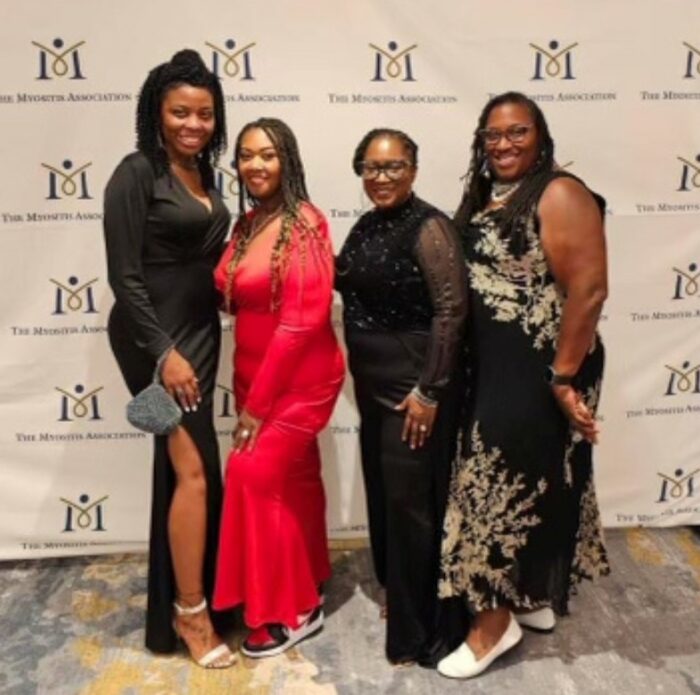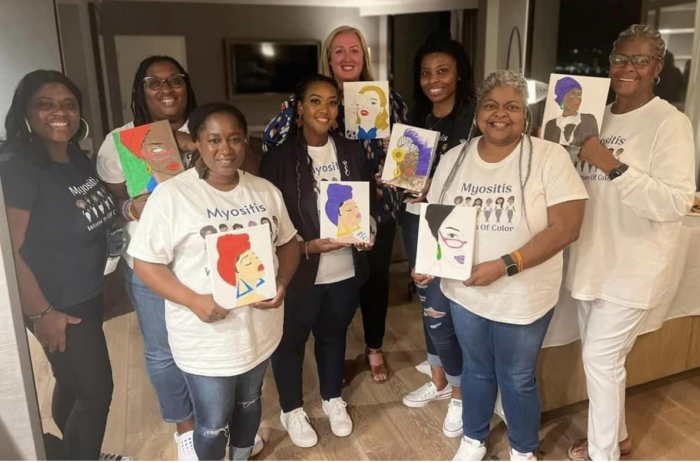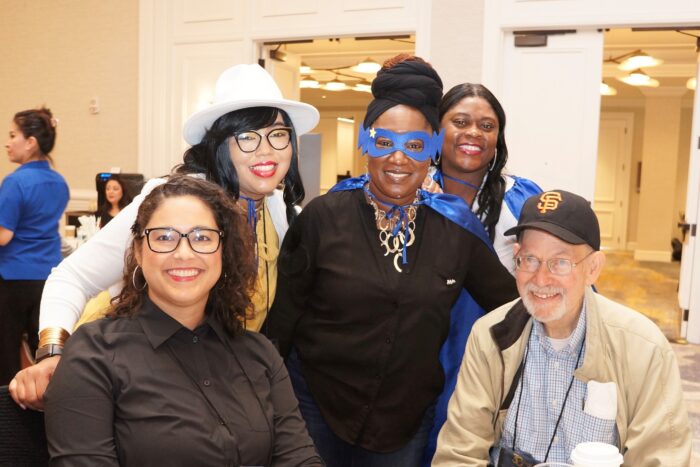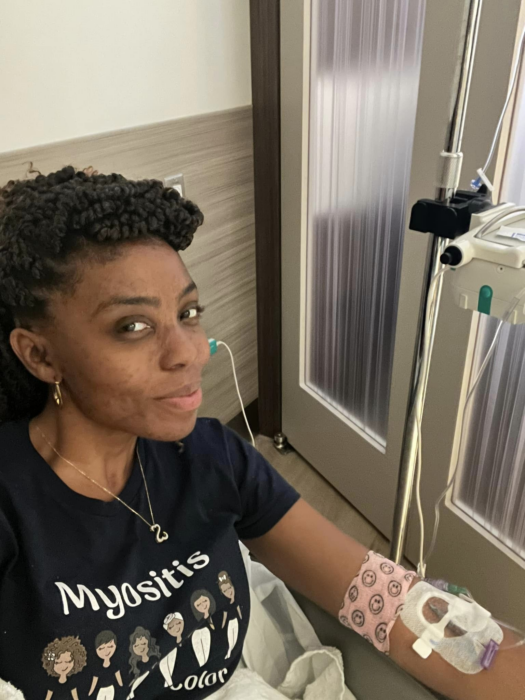Written by Linda Kobert and Holly Jones
In 2018, the TMA staff noticed at the Annual Patient Conference that most participants were White. We understood, however, that the myositis community was more diverse than was represented at the conference. From demographic data, we knew that women outnumber men with all forms of myositis except IBM by two or three to one. Additionally, we were aware of data that informed us that Black and Latinx Americans, especially women, were disproportionately affected by these diseases. So where were they? And how could we connect them with our support and educational programs that would help them better navigate the challenges of these diseases?
Working with members of the Medical Advisory Board, TMA gathered data documenting how the burden of myositis disease was greater for women of color. For example, the rash of dermatomyositis is often more difficult to see on darker skin, making the diagnosis more of a challenge. Black patients with antisynthetase syndrome were known to have more severe lung disease than White patients, which leads to higher mortality. TMA developed educational materials using this data and devised a plan to distribute TMA’s resources to communities of color. They understood, however, that an effective outreach initiative would need the input of women who experience these challenges.
Call to action
TMA approached several members, including Holly Jones and Kaniah Gunter, and invited them to brainstorm with and advise them on raising awareness of myositis among communities of color, especially women. Holly was diagnosed with polymyositis and interstitial lung disease in 2003 at the age of 19 and was diagnosed in 2014 with pulmonary hypertension during her third pregnancy. Her experience with myositis captured the audience of young adults navigating their new normal as they begin adulthood.
Kaniah was diagnosed in 2007 at the age of 26 with dermatomyositis, calcinosis, and scleroderma. At the beginning of her diagnosis, she dealt with gastrointestinal issues and malnutrition from dysphagia. She made it her mission to educate others, especially women of color, about living a healthy lifestyle with an autoimmune disease.

This advisory panel soon morphed into the Myositis Women of Color Support Group in 2020, created by Holly. Under the leadership of Chrissy Thornton, TMA’s first affinity group for women of color living with myositis was launched in 2021. We became its leaders and recruited other women through social media, personal contacts, and word of mouth. Since that time, we and our myositis sisters have been tireless in our efforts to unite and empower women of color affected by myositis and to advocate for their health and well-being. Today, nearly 50 women participate in TMA’s Women of Color Affinity Group virtual meetings each month, and the group boasts a membership of more than 250 individuals and 730 social media followers. This year, we are excited to celebrate five years of TMA’s Women of Color Affinity Group advocating for all women of color living with or caring for someone with any form of myositis.
The three E’s
In line with the group’s vision to Encourage, Educate, and Empower individuals who live with myositis, each year TMA’s Women of Color Affinity Group hosts a range of interactive opportunities that are open to everyone in the community. For the fifth year running, for example, the group hosted a panel discussion at TMA’s International Annual Patient Conference in 2024. By assembling a diverse set of speakers for these events focus attention on reducing the disparity gap in myositis outcomes for people of color, while also fostering an inclusive community of strength, perseverance, and inspiration.
Women of Color actively support TMA’s monthly webinar series as well, offering presentations to the community on topics our members are interested in for their myositis journey. Our session on the Impact of Social Connections on Patient Health Resilience and Maternity in Myositis are among the most-watched videos on TMA’s YouTube channel. The affinity group’s virtual monthly meetings, which are open to everyone, also provide presentations by expert speakers, empowering resources, and uplifting personal stories.
But our efforts don’t stop when the Zoom meeting ends. Members provide support and comfort, often in person, both individually and as a group, any time we find out someone needs a little love. For example, our Advocate Buddy program, “I Got You,” means members never need to go solo to a doctor’s visit or medical procedure. When someone puts the word out, a local group member will reach out to help.

Holly says, “In our monthly meetings I always use the phrase ‘We got you’ when someone needs a resource or assistance. I never imagined that my passion for networking would be so rewarding. Meeting virtually every month provides great encouragement and education. However, being able to physically see and hug someone who is a mirror image of yourself, especially when you feel alone, is incredibly empowering and cannot be matched. There is a certain confidence that comes with knowing that someone has your back.
“Kaniah and I promote sisterhood. We cater to so much more than myositis inside our group. I often say that myositis is what brings us together, but life experiences are what bond us forever,” says Holly, who is serving her third year on TMA’s Board of Directors.
Members are there for each other during both tough and joyful times. If someone is dealing with a difficult situation like a cancer diagnosis or a challenging divorce, other members will organize one-on-one meetups, phone calls, or video chats to offer support. We also celebrate happy occasions such as engagements and new babies. It’s the type of support one would hope for from a beloved aunt or a close friend who understands what it’s like to live with a devastating chronic disease.
Kaniah mentioned that she noticed an increase in the frequency of the support calls, which led us to brand these calls as “Encouragement Calls” after the group’s 3E’s theme.
“These calls provide one-on-one support and help to enhance the intimacy and connection among the women in the group. We are committed to being accessible leaders and creating a comfortable, safe, and trusting environment. I believe these calls provide valuable insight into the well-being of our group members while providing them extra support,” Kaniah says.
Extending the Community

You don’t have to be a woman or Black to be part of TMA’s Women of Color Affinity Group. People of all races and genders, from every part of the world, are welcome to participate in the monthly virtual meetings. This affinity group attracts people from all of TMA’s other support and affinity groups, including TMA’s Adelante! (an affinity group for Spanish speakers), Care Partners, Flying Solo, Men Managing Myositis, Military Veterans, Rainbow Warriors, and Women with IBM.
“We will never turn anyone away,” Holly states. “We are spiritual women, and we genuinely care for our members. Our mission focuses on promoting inclusivity and providing comprehensive support for everyone.”
Somewhere along the way, men started showing up at TMA’s Women of Color Affinity Group meetings too. They were welcome, of course, but as more and more men found something of value in connecting with this community of color, it became apparent that a new affinity group was needed. We knew exactly who to ask to help lead this new group: Holly’s friend Sherrod Bundage, a myositis influencer, and fellow TMA Board member Mustafa Shameem. After a meeting with TMA staff, in February of this year TMA’s Men of Color Affinity Group had its first meeting, and it was a success!
Similarly, TMA has 2,500 members in 116 countries. Nearly 100 of those are in Africa, where people are often desperate for knowledge about myositis and crave support in managing their disease in places where healthcare resources are in very short supply. We raised awareness of this need and worked with TMA staff to organize the first myositis support group based in Africa. Now Myositis Africa is thriving among TMA’s regional support groups.
The Chosen Family

When individuals first come across TMA’s Women of Color Affinity Group, they are excited to find kindred spirits who share similar experiences and challenges. “I thought I was the only one,” they often express, revealing their sense of isolation before joining.
“They confide in us about never encountering another person of color in similar support groups, indicating a profound lack of representation and support,” Holly says.
“So, we help them connect the dots. That’s what gets us excited, for them to find a home, to find their chosen family,” Kaniah says.
As we evolve
TMA’s Women of Color Affinity Group has several stellar committees! The Welcome Committee ensures that everyone stays connected and contributes data for the group’s two programs. The BWC Committee (Bereavement and Wellness Check) ensures that any member in the hospital or who has passed away receives condolences on behalf of the group. The Social Media Committee keeps everyone in the group and the public updated on TMA news and WOC activities. We also create promotional videos and flyers, some of which have reached over 80,000 views. The Fundraising Committee has participated in TMA campaigns such as Fun Fit Flex.
Embrace positivity through life’s challenges
Despite our achievements, the journey of our group has not always been easy. We have dealt with internet bullies about prejudice and racist Zoom hackers. We battled personal setbacks due to new diagnoses. And we still cope with the loss of our members to myositis. All of which have taken a toll on our mental and physical health and personal lives. We understand the importance of being pioneers in our field of advocacy. It is crucial for the work we do to reflect positively on our character, the group, and the organization that supports us. We feel it is our responsibility to provide to women of color the kind of support, services, and resources that we did not have when we first started out on this journey. And we are committed to advocating for changes that affect us all: a shorter time to diagnosis, better treatments, and health equity.


I have gone to a few meetings and thoroughly enjoyed them. That’s where I learned about the Helacells! However, I usually miss the meetings because of my crazy life. My spare time on Thursday evenings usually doesn’t start until about ten at night.
Do you have a newsletter or something thar shows the time and date of each meeting. Also, do you provide information on the topic for the meetings. I would be thrilled to have that information.
Joyce, TMA’s Women of Color Affinity Group meetings happen on the first Thursday of the month at 6:30pm ET. We do have a newsletter that is sent to members on the first of the month. You can sign up for our mailing list here: https://www.myositis.org/join-tma/ Many of our other support and affinity groups also meet virtually throughout the month. You can see the schedule and register for these meetings through our calendar here: https://www.myositis.org/calendar/
Welcome lady warrior Joyce and thank you so much for joining The Women of Color Affinity Group. So glad you were able to get the support and enjoyed our meetings. We look forward to seeing you at our next meeting. Please know we are here to Encourage,Educate and Empower you💙